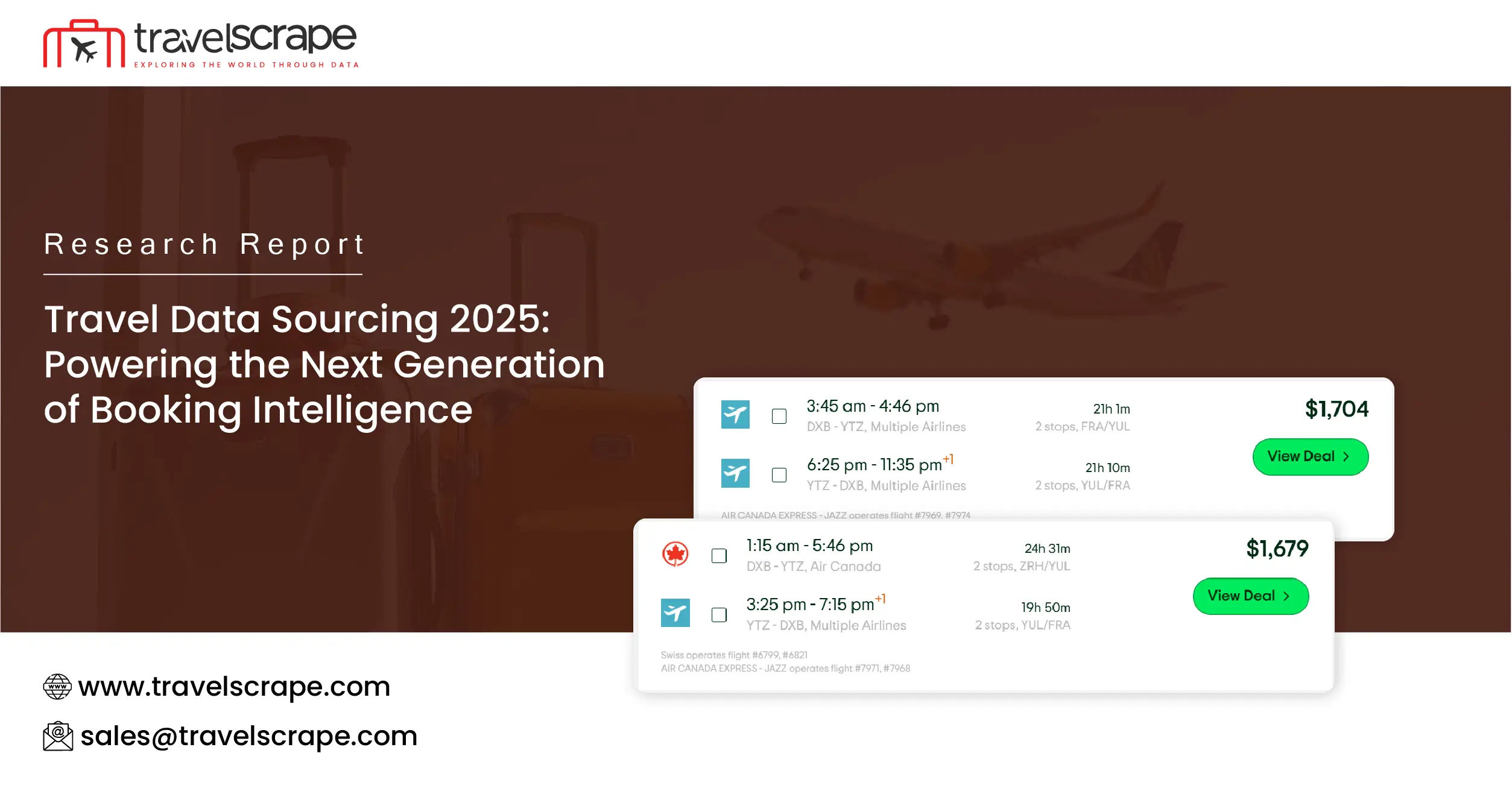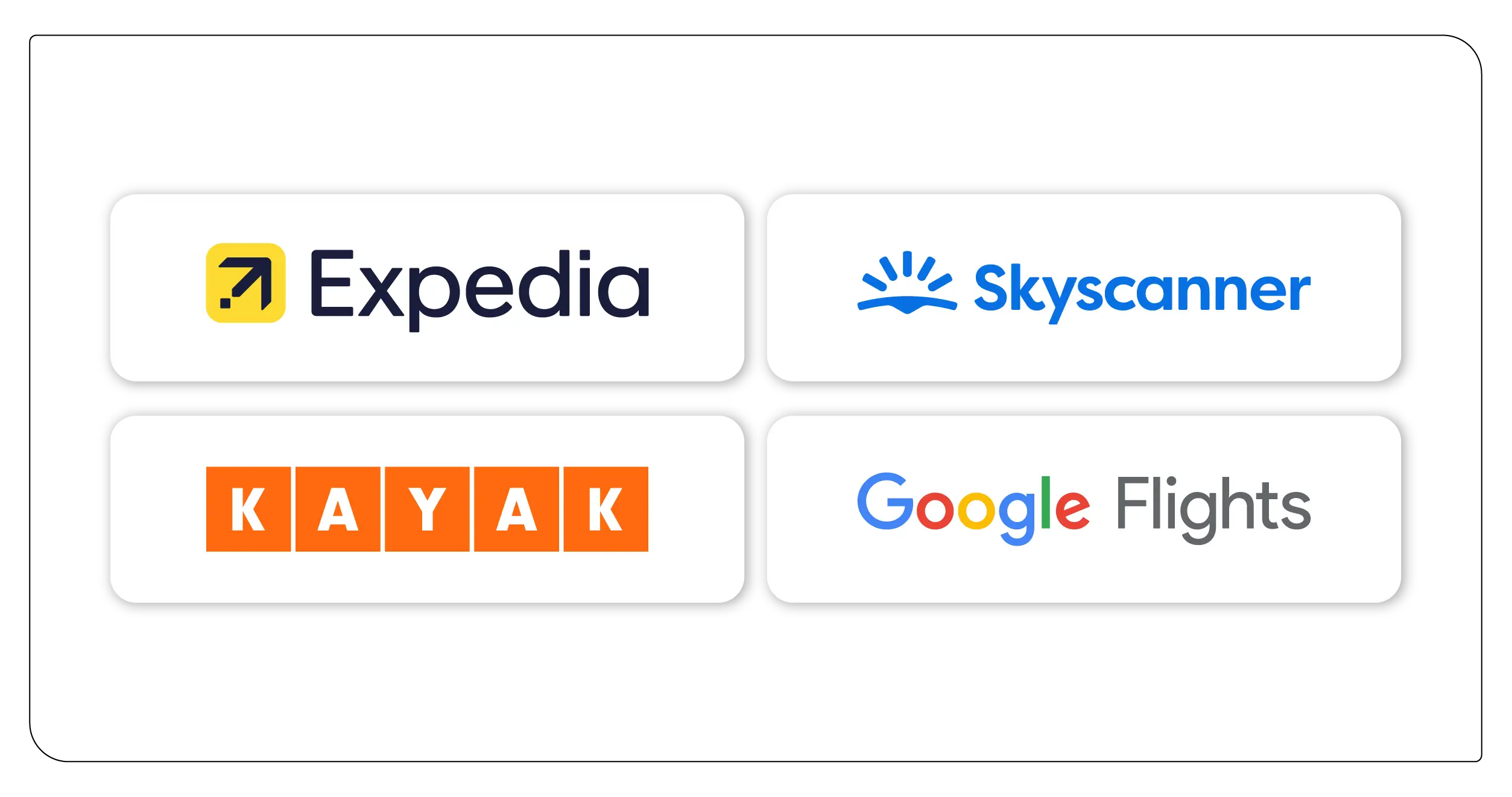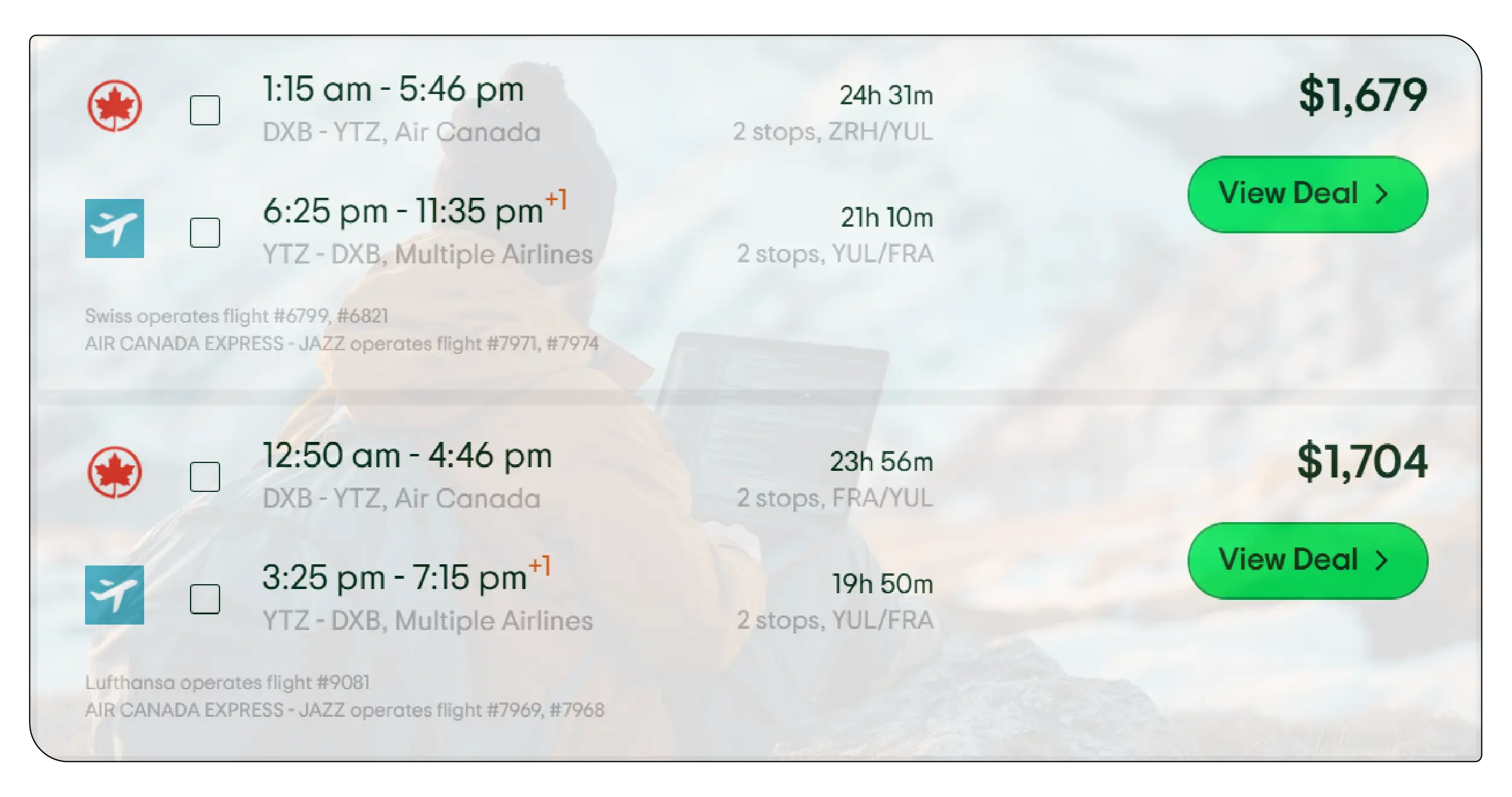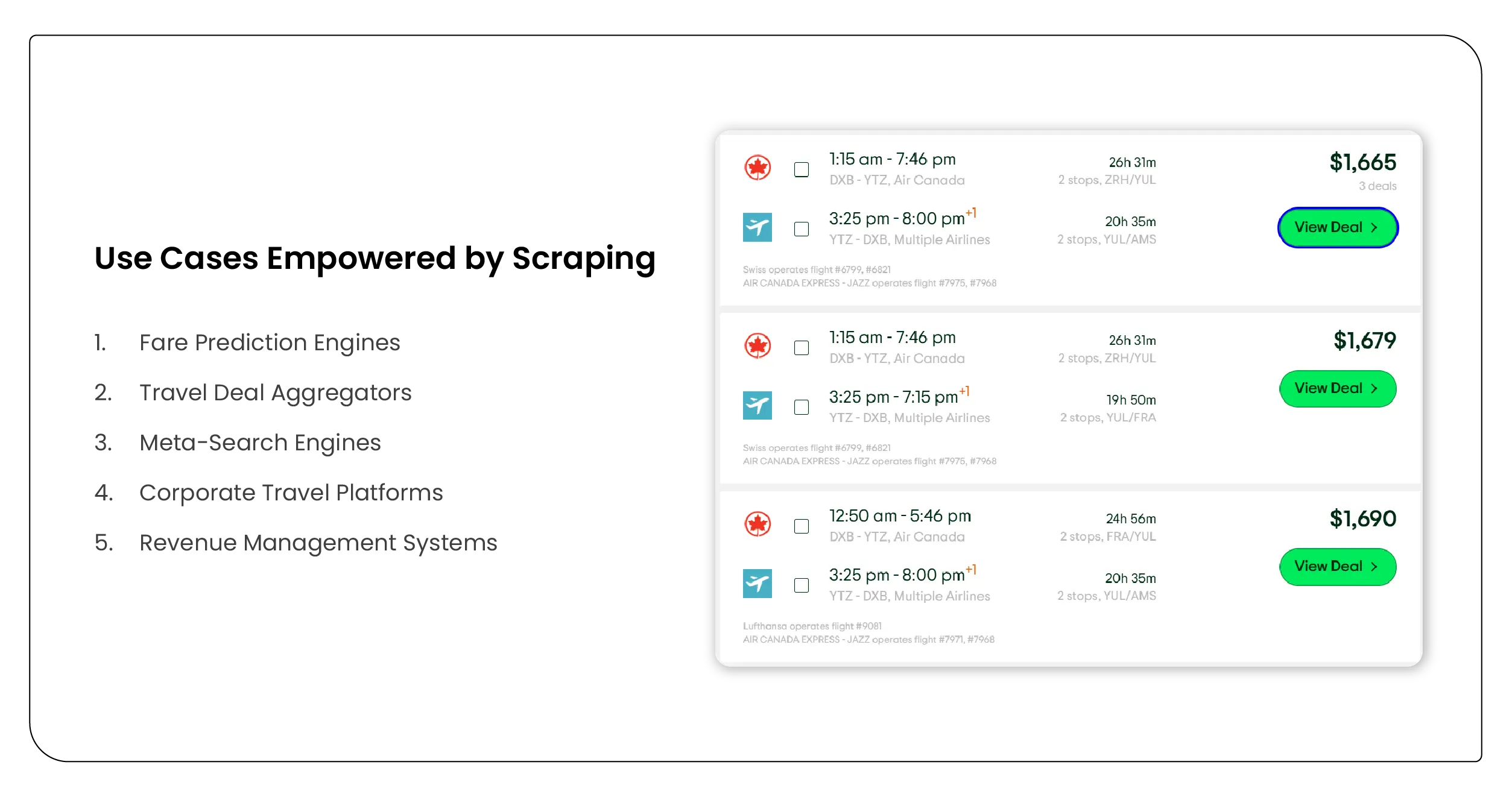Travel Data Sourcing 2025: Powering the Next Generation of Booking Intelligence

Introduction
With global travel surging in 2025, the demand for travel data sourcing 2025 has become critical for travel startups, booking engines, and analytics platforms. Businesses now rely heavily on accurate, real-time access to pricing, availability, and route data to remain competitive. The choice between scrape vs API travel data plays a pivotal role in determining data flexibility, coverage, and cost-effectiveness. Among the most transformative methods is travel aggregator data scraping, which enables platforms to collect live fare information, flight schedules, and seat availability directly from competitor sources. This approach enables platforms to track dynamic pricing, detect promotions, and respond to market shifts quickly. This report delves into the tools, technologies, and scraping strategies outlined in modern aggregator scraping guide frameworks. It evaluates how travel companies can scale sourcing operations efficiently, highlighting the role of scraper automation, API augmentation, and hybrid data pipelines in shaping the future of travel data infrastructure.
Evolving Travel Aggregator Infrastructure

In 2025, travel aggregator platforms such as Expedia, Kayak, Skyscanner, and Google Flights have expanded their databases to accommodate not only flights but also multi-modal transportation, hotels, and vacation rentals. These platforms consolidate data from thousands of airlines, OTAs (Online Travel Agencies), and direct airline APIs to deliver a unified experience to the end-user. To feed analytics and pricing engines with similar data, tech companies must choose between API partnerships or strategic flight API vs scraper methods.
Table 1: Comparison – API vs Scraping for Travel Data (2025)
| Parameter | API Integration | Web Scraping |
|---|---|---|
| Data Access | Limited to API restrictions | Full visibility if structure is known |
| Real-Time Pricing | High (but sometimes cached) | Real-time when scraper is well-configured |
| Cost | Often involves licensing fees | Initial setup cost; low ongoing cost |
| Flexibility | Low – provider controls scope | High – can target any visible component |
| Legal Compliance | High – if terms are followed | Medium – depends on target site's terms |
| Data Fields | Predefined | Fully customizable |
Integration Options in 2025
In 2025, most OTA (Online Travel Agency) platforms rely on hybrid OTA integration methods , combining direct airline APIs with scraping-based backups to enhance data redundancy and reliability. While travel APIs deliver structured and clean data, they often come with constraints such as rate limits, access restrictions, or high usage costs. As a result, many developers adopt scraping techniques to fill these gaps. Scraping provides greater flexibility and allows access to data not always available through APIs, such as real-time seat inventory or historical pricing. A prime example is Skyscanner data extraction, where scraping tools help gather broader market intelligence, including competitor fares and dynamic pricing trends. This approach enables platforms to maintain a competitive edge by ensuring consistent access to critical travel data, regardless of limitations imposed by API providers.
Key Findings

- Travel Aggregators Data Scraping in 2025 is more accurate due to advances in headless browsers and dynamic scraping techniques.
- Scraping and API methods are increasingly used in combination to achieve richer datasets and historical trend building.
- Airlines and OTAs are adapting with dynamic content and anti-bot measures, increasing complexity for Travel Scraping API systems.
- Real-time Airlines Data Scraping is vital for platforms relying on fare intelligence and surge pricing alerts.
- Regulatory compliance varies widely by region, and respecting robots.txt and platform T&Cs is essential when Scraping Major Aggregators.
Table 2: Sample Aggregator Data Collected in May 2025
| Aggregator | Routes Tracked | Average Fare Accuracy | Update Frequency | Scraping Method | API Alternative |
|---|---|---|---|---|---|
| Kayak | 5,000+ | 98% | Every 6 mins | Headless Chrome | Yes |
| Skyscanner | 4,500+ | 97.2% | Every 10 mins | Puppeteer | Yes |
| Expedia | 3,800+ | 96.5% | Every 15 mins | Selenium | Limited |
| Google Flights | 2,500+ | 99% | Live | API + Backup Scraper | Yes |
| Hopper | 3,000+ | 95% | Every 20 mins | Python Scrapy | No |
These aggregators form the core of today's Travel Web Scraping Service offerings. Tools are optimized to extract data points like Airline Fares, layovers, refundability, booking links, and more.
Analysis of Sourcing Methods
Platforms aiming for fare intelligence or itinerary mapping often employ hybrid models. While Kayak data scraping offers near-complete route intelligence, platforms prefer to combine it with static APIs for flight metadata. In scenarios where APIs fail to update promptly or do not offer granular price histories, scrapers provide a vital backup.
Modern travel tech data pipelines include automatic scraper updates, region-specific fare capturing, and historical fare databases. This layered architecture supports use cases like competitive benchmarking, flash sale detection, and anomaly pricing alerts.
For global reach, especially when sourcing flights and bookings from fragmented OTAs, maintaining unified travel data sources across regions becomes essential. This requires scalable bots, proxy infrastructure, and adaptive parsers.
Observation
The shift to real-time aggregator scraping in 2025 has been largely driven by consumer demand for instant price comparisons and last-minute deal detection. Larger booking engines now embed scraped data in visual dashboards that track competitors' offers down to hourly intervals.
Smaller startups often lack API partnerships, making scraping their default method of sourcing travel data efficiently. However, they must balance efficiency with legal clarity and infrastructure scalability.
Security has also become a factor. With many aggregators deploying bot blockers and JavaScript-based rendering, scraping infrastructure now includes CAPTCHA solvers, anti-bot signature rotation, and human-behavior emulation.
Challenges in 2025
- Anti-bot technologies like Cloudflare and reCAPTCHA continue to obstruct scraping routines.
- Legal ambiguity around scraping publicly visible fare data varies across jurisdictions.
- APIs, while structured, often lag behind scrapers in terms of flexibility and speed.
- The growing complexity of aggregator platforms increases maintenance costs of custom scrapers.
- Travel inventory changes rapidly, making high-frequency scraping necessary for up-to-date insights.
Use Cases Empowered by Scraping

- Fare Prediction Engines – Combine API and scraping sources to forecast upcoming price trends.
- Travel Deal Aggregators – Highlight best deals across OTAs in real time.
- Meta-Search Engines – Provide users with cross-aggregator comparisons using unified data layers.
- Corporate Travel Platforms – Monitor travel cost optimization via dynamic data feed.
- Revenue Management Systems – Benchmark airline prices across competitors in milliseconds.
Conclusion
Travel data sourcing in 2025 is a complex, multi-layered process involving a mix of direct APIs and robust scraping engines. The emergence of real-time insights, fare prediction systems, and deal aggregation platforms depends on reliable and adaptable scraping tools. As travel booking API trends evolve, many platforms will continue investing in hybrid data models to improve accuracy and reduce dependency on any single source.
While APIs remain essential for stable partnerships, third-party travel data collection through scraping is becoming indispensable for agility, broader coverage, and commercial competitiveness. For developers and analysts, mastering the nuances of scraping aggregator platforms is key to staying ahead in the evolving travel tech landscape.
Ready to elevate your travel business with cutting-edge data insights? Get in touch with Travel Scrape today to explore how our end-to-end data solutions can uncover new revenue streams, enhance your offerings, and strengthen your competitive edge in the travel market.

